Introduction to the war at sea during World War One
When most people think of World War One, they think of trenches and machine guns. However, there was another side to the conflict – the war at sea.
In 1916, the Battle of Jutland saw the war’s largest naval battle as the navies of Britain and Germany fought for control of the North Sea.
Meanwhile, below the waves, German submarines sought to sink supply ships and starve Britain out of the war.
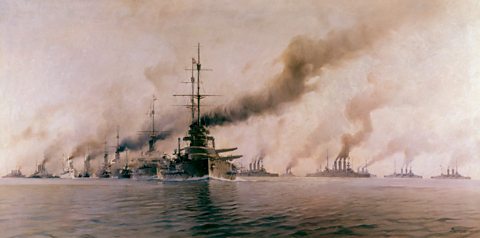 Image source, ALAMY
Image source, ALAMYWatch: The Battle of Jutland, 1916
Watch this video to find out about the naval arms race between Britain and Germany and how it led to the Battle of Jutland.
Find out why the Battle of Jutland posed a real problem for the British Navy in World War One.
May 30th 1916, sixteen-year-old Archibald Dickson stands proudly aboard the HMS Queen Mary, steaming into battle in the North Sea to teach the pesky little German Navy a lesson. But when they arrive, the British get the shock of their lives. The German fleet in way bigger than expected, headed up by enormous, terrifying Dreadnought ships.
The battle is deadly; ships go up in flames on both sides. Explosions ripple across the water, while massive Dreadnoughts fire everything they have. And all it takes is a single shell smashing into a gunpowder store for a ship like the HMS Queen Mary to explode, taking Archibald’s life amongst 1,266 others on board.
This was the Battle of Jutland – thousands of deaths, and not the easy victory the Brits were expecting. In fact, it was hard to tell who’d actually won. How did the Brits get it so wrong? Let’s backtrack…
In 1914, Britain had the largest navy in the world, but Germany wanted one that would rival it. In the lead up to the war, Germany and Britain raced to build the most ships possible. But not just any ship, both sides wanted to build the most Dreadnoughts, a new kind of warship that was bigger, better, and outclassed everything else at sea. Heavy guns, steam powered, turbine engines – the works.
Britain depended on getting food, weapons, and supplies shipped from the US and Canada – a potential weak spot. If the Germans could use their brand-spanking new navy to stop that, sinking ships and cutting off supply lines, they could starve Britain out of the war.
So, the British Navy had one clear goal – to keep the German Navy out of the Atlantic at all costs. It was all leading up to an inevitable battle, starting on the 31st May, 1916.
Hours of brutal fighting, involving 250 ships, forty Dreadnoughts and resulting in over 8,500 lives lost at sea. Both nations claimed victory, but at a cost. Britain lost more ships and men than Germany, but after the battle, the German Navy was left stuck in their ports, never to be a threat again.
Whilst the fierce reputation of the British Navy took a knock, they did ultimately succeed in keeping all the important Atlantic supply lines active.
The war at sea was far from over, however. Germany changed tack, putting their efforts into submarines called U-boats, which were cheap and could slip through blockades and cause a lot of damage. The imagined ‘Great War at Sea’ became a cat-and-mouse game of German U-boats trying to sink supply ships in the Atlantic and the British Navy trying to stop them.
What caused the Battle of Jutland?
By the time World War One broke out, Britain had the world's most powerful navy.
In the 1880s, the German Emperor, Kaiser Wilhelm II, decided to build a navy to rival that of the British.
This decision led to a competition to build larger, deadlier ships that were faster and had larger guns onboard.
The Kaiser Wilhelm Canal
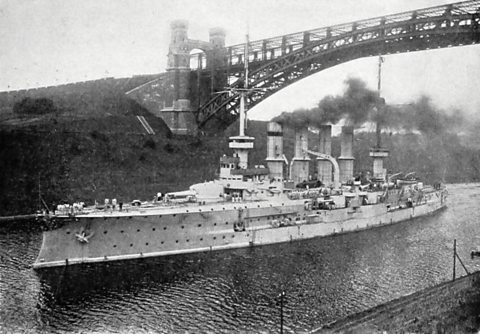 Image source, ALAMY
Image source, ALAMYOne block to the Kaiser's naval ambitions was geographic: in order for German warships to reach the North Sea and the Atlantic they first had to sail all the way around Denmark.
To address this, in 1887 work began on a new canal that would run all the way across Denmark.
Called the Kaiser Wilhelm Canal (now known as the Kiel Canal), it allowed the German Baltic Fleet to move from their bases to the North Sea faster by avoiding the journey of sailing around Denmark.
Britain saw the creation of the canal as a direct threat and the Government decided to implement reforms which would modernise the British fleet in response.
 Image source, ALAMY
Image source, ALAMYThe age of the dreadnoughts
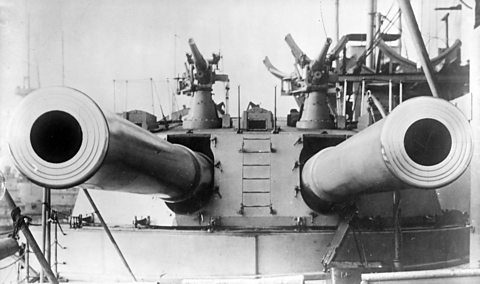 Image source, ALAMY
Image source, ALAMY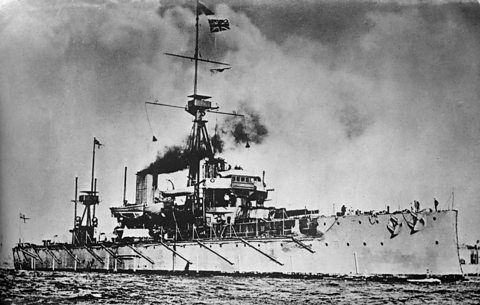 Image source, ALAMY
Image source, ALAMYIn 1906 the British launched the HMS Dreadnought. At the time, the ship was the fastest warship in the world and it featured ten enormous guns that could fire shells at long range.
This class of ships became commonly known as ‘dreadnoughts’ and it led to a naval arms race between Britain and Germany to develop bigger and better battleships.
In 1907, the German Navy responded and launched their own version of the Dreadnaught, the SMS Nassau.
Each year the two countries tried to produce more battleships than the other and, by 1914, Britain had 22 dreadnaughts whilst Germany had 15 ships of the same type as the Nassau.
On the outbreak of war, these two huge navies would fight it out for control of the seas.
 Image source, ALAMY
Image source, ALAMYWhat happened at the Battle of Jutland, 31st May to 1st June, 1916?
 Image source, ALAMY
Image source, ALAMYThe Battle of Jutland was the largest naval battle of World War One.
The battle took place in the North Sea off the coast of Denmark.
Since the start of the war, the British Navy had blockaded German ports and prevented supplies, including food, from reaching Germany. The German Naval Command hoped to end the blockade.
They aimed to ambush and destroy parts of the British fleet so that German warships could have greater access to the North Sea and the Atlantic.
For the British, the battle was very important. If the German's were successful, then their navy could BlockadeTo forcibly prevent goods or people from entering or leaving a location. Britain's ports and stop shipments of food and ammunition arriving.
This could lead to starvation in Britain and weaken the nation's ability to wage a war against Germany.
 Image source, ALAMY
Image source, ALAMYWhat was Germany's plan at the Battle of Jutland?
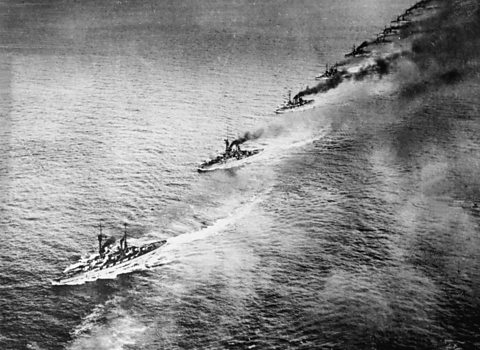 Image source, ALAMY
Image source, ALAMY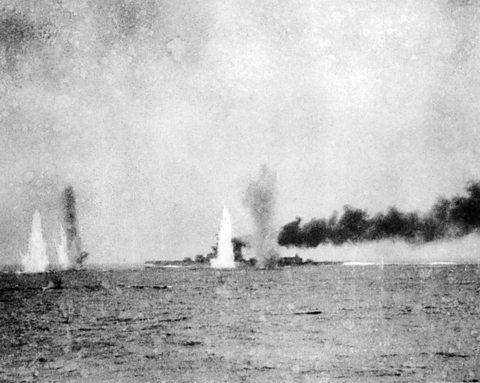 Image source, ALAMY
Image source, ALAMYThe German plan was to lure a smaller section of the British naval fleet out of port and then destroy them with the full force of the German navy.
However, before the battle, the British had intercepted German communications and learned of the plan. Instead, the full British fleet sailed to meet the Germans.
The battle involved 250 ships and roughly 100,000 sailors. At first, the German navy had the upper hand and succeeded in separating a part of the British fleet and sinking several ships.
Later, the tide of the battle turned to favour the British. Realising that they were outgunned and in danger of being cut off from the safety of their own ports, the German navy withdrew from the battle.
 Image source, ALAMY
Image source, ALAMYWho won the Battle of Jutland?
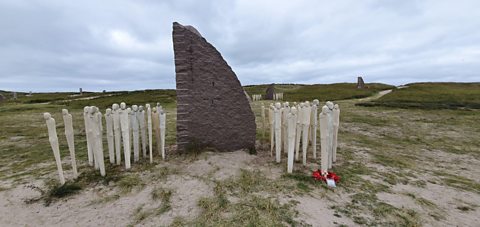 Image source, ALAMY
Image source, ALAMYThe battle failed to achieve the decisive victory each side hoped for but both sides claimed victory.
For Britain, it confirmed their naval dominance and secured British control of shipping lanes. This allowed Britain to continue the blockade of German ports that would contribute to German defeat in 1918.
Germany claimed victory as the British losses were heavier than their own – Britain lost 14 ships and over 6,000 men, whilst the Germans lost 11 ships and over 2,500 men.
Despite sustaining the heavier losses, the British fleet was quickly ready to go back to sea. The leaders of Germany's navy realised that they could not continue this level of conflict against the larger British fleet. Never again did the German fleet seriously challenged British control of the North Sea.
 Image source, ALAMY
Image source, ALAMYU-boats and convoys in World War One
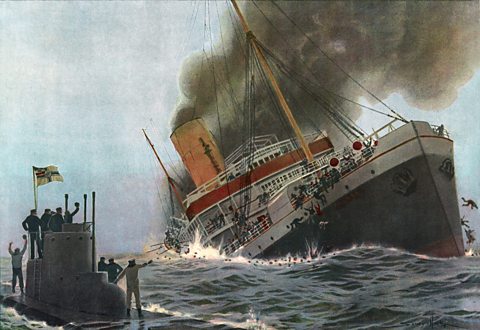 Image source, ALAMY
Image source, ALAMYAs the German Naval Command realised that they would not be able to defeat the British in a naval battle, they turned to other means to try and force Britain into submission.
The most effective and deadly involved unrestricted submarine warfare. The Germans argued that if a ship was carrying supplies to one of its enemies, be that weapons or food, then it was a legitimate target.
This new strategy was not without its dangers, however.
How were U-boats used in World War One?
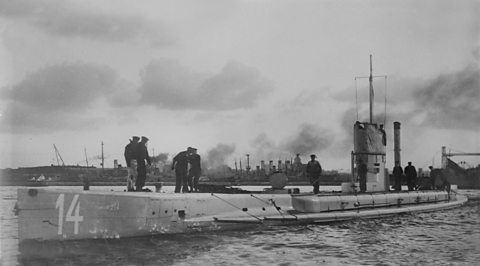 Image source, ALAMY
Image source, ALAMY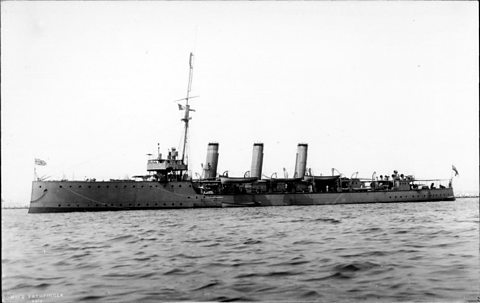 Image source, ALAMY
Image source, ALAMYGerman submarines – called U-boats – had been active from the start of the war. They largely targeted British naval ships but they had also sometimes attacked ships bringing supplies to Britain.
On the 5th September 1914, HMS Pathfinder became the first ship to be sunk by a modern self-propelled torpedo.
HMS Pathfinder was a small cruiser-style warship. The ship was sunk in the Firth of Forth off the east coast of Scotland by the German U-boat, SM U-21.
258 men lost their lives as Pathfinder exploded and then sank.
 Image source, ALAMY
Image source, ALAMYWhy was the Lusitania important in World War One?
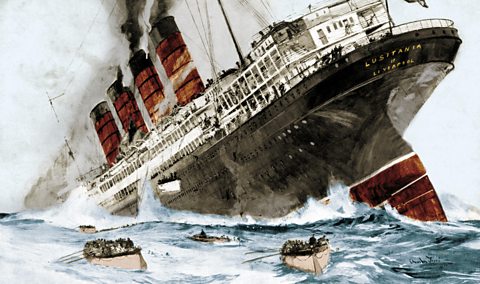 Image source, ALAMY
Image source, ALAMYIn 1915, the British passenger ship, RMS Lusitania, was torpedoed and sunk by a U-boat off the coast of Ireland. 1,197 people died in the attack.
Several of those killed were American citizens. This lead American president, Woodrow Wilson to insist that Germany stop submarine warfare against non-military ships.
Fearing that America might join the war against them, the Germans agreed to limit their use of U-boats
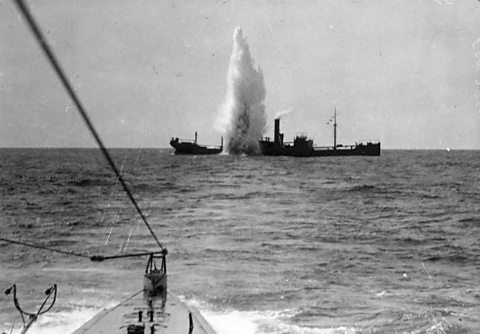 Image source, ALAMY
Image source, ALAMYBy 1917, the Germans realised that they were losing the war and needed new tactics to defeat their enemies. In response, they returned to submarines.
Britain depended heavily on imports from abroad for necessities such as food. The new German plan was to use their U-boats to sink the merchant ships that carried these essential supplies.
If the German plan succeeded, Britain could be starved out of the war.
There was no doubt that the U-boats could inflict serious damage. By 1917, Germany's 140 U-boats had sunk almost a third of the world's merchant ships. (Source: National WW1 Museum and Memorial, USA.)
 Image source, ALAMY
Image source, ALAMYWhat was a convoy in World War One?
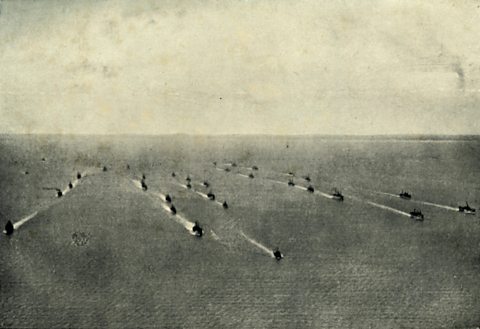 Image source, ALAMY
Image source, ALAMYBy April 1917, Britain had lost 373 ships carrying much needed supplies (a total weight of 873,754 tons) to German U-boats.
At a time when food rationing was starting to be introduced at home and morale was beginning to wane, the British Government could no longer stand aside and watch German submarines sink vital supplies.
On 24th May 1917, Britain introduced its convoy system.
Under the new arrangements, a convoy of 10 to 50 merchant ships would be escorted by armed navy vessels.
Typically this armed guard featured a cruiser, six destroyers, eleven armed trawlers, and two torpedo boats. Seaplanes were used to detect the movement of submarines before they stuck. depth chargeAn explosive device that could be detonated underwater to destroy submarines. were used against submarines while they were underwater, and ships were fitted with rams to destroy U-boats on the surface.
How successful was the British convoy system in World War One?
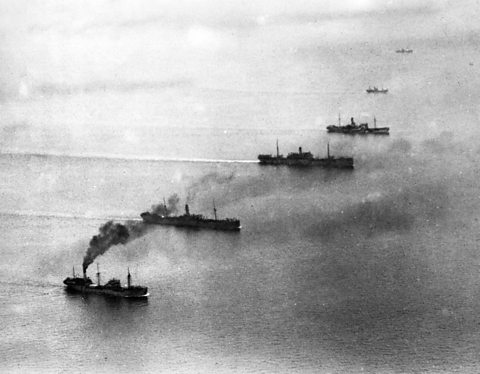 Image source, ALAMY
Image source, ALAMYThe armed convoys helped Britain maintain the supplies it needed to survive and continue to fight in the war.
The convoys were an immediate deterrent against U-boats and ended any German hope of starving Britain into submission.
They also allowed safe passage for American troops, enabling over one million US soldiers to cross the Atlantic Ocean and join the Allied war effort to defeat the Germans in 1918.
 Image source, ALAMY
Image source, ALAMYTest your knowledge
More on World War One
Find out more by working through a topic
- count7 of 9
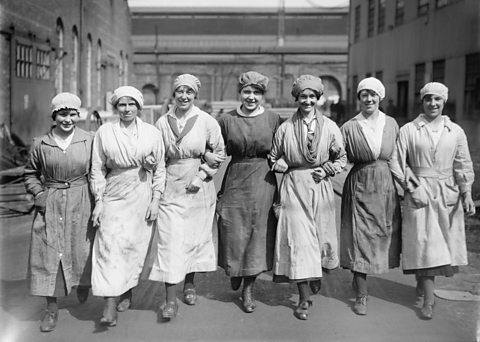
- count8 of 9
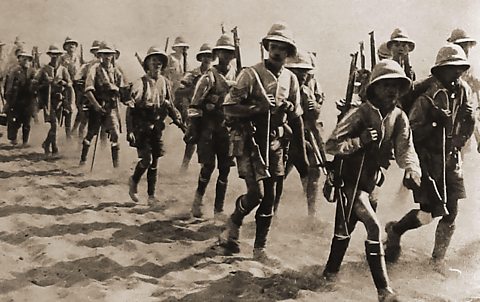
- count9 of 9
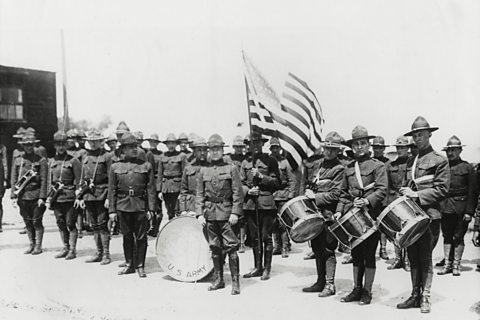
- count1 of 9
